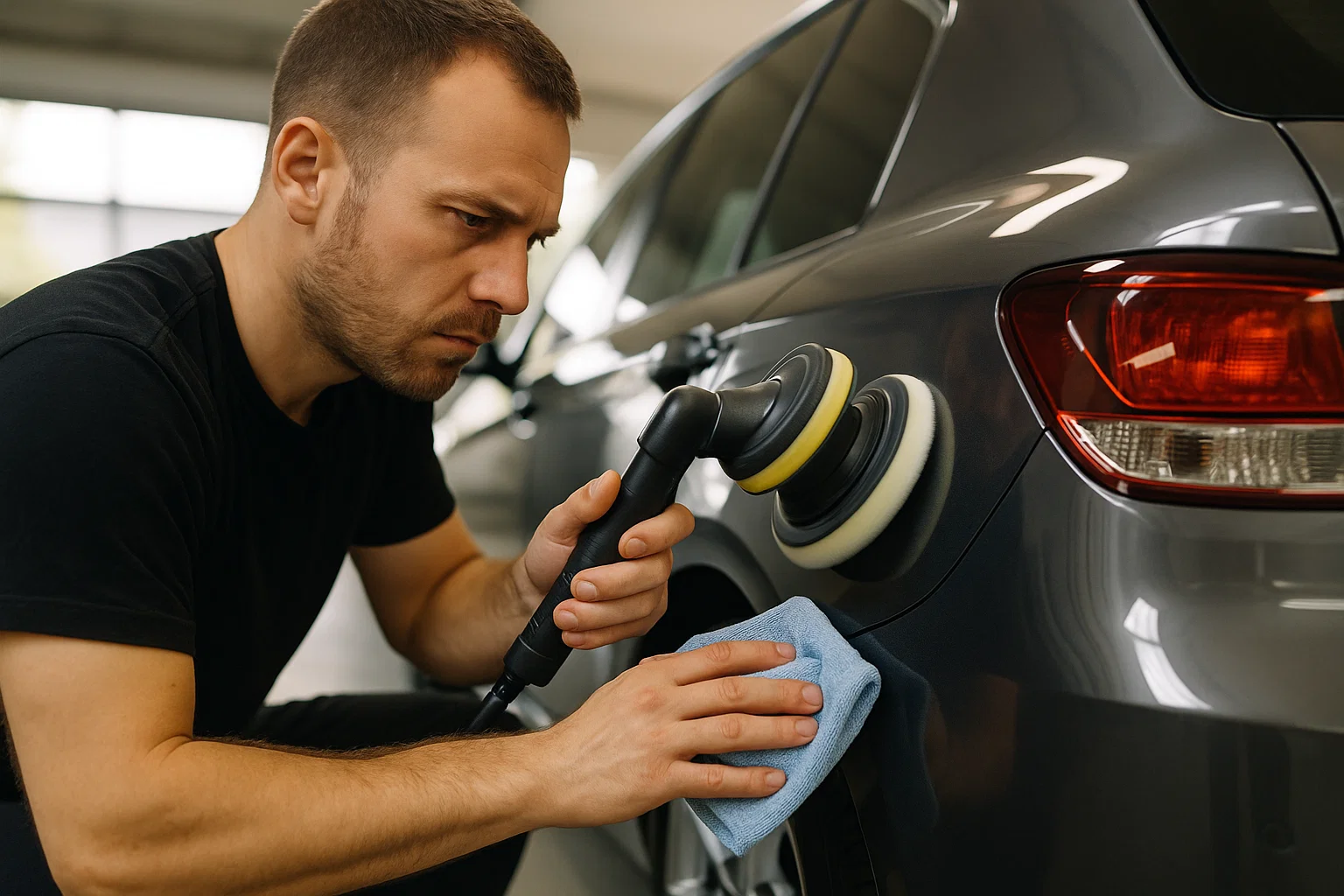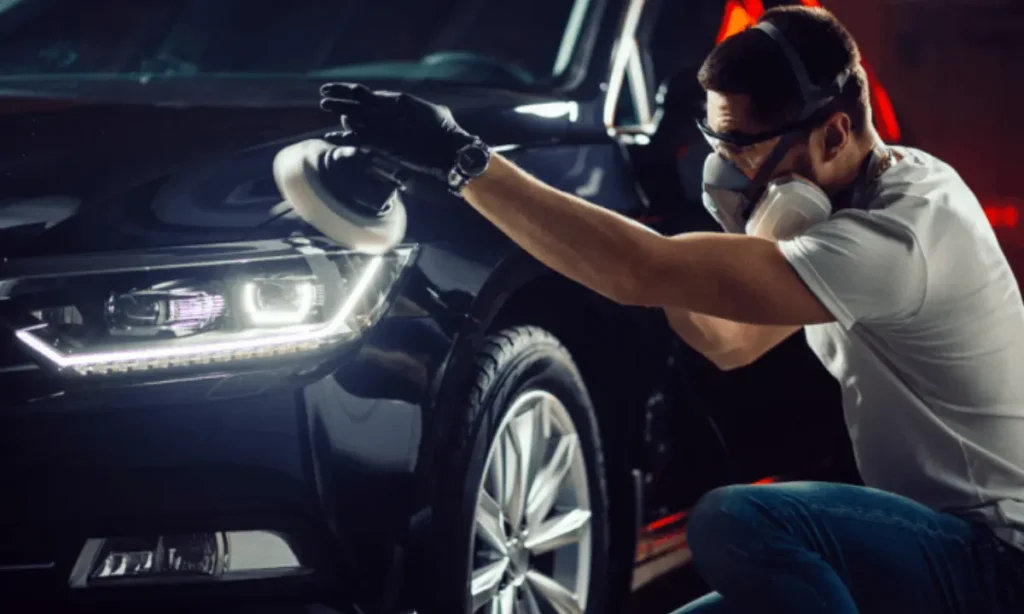Paint correction is perhaps one of the least understood yet most powerful tools in the professional detailer’s arsenal. If you’re still trying to figure out why your car’s finish doesn’t have that show-shine or seems to be covered with tiny swirls, paint correction may be the answer. This guide includes what is paint correction, why paint imperfections happen, the cost to correct, and whether it’s the right fit as an automotive investment for your car.
Understanding Paint Correction
Many people mistakenly see paint correction as just a cosmetic procedure but there’s much more to it than just looks. Experts refer to this as paint surface enhancement, and the process removes minor defects that can not be removed by washing and polishing alone. If your car’s paint looks dull, scratched, or has plenty of swirl marks, a true paint correction service can reverse that damage and restore the car’s paint to like-new.
What Does Paint Correction Do?
Paint correction involves the removal of imperfections on the surface of your car, such as swirl marks, fine scratches, water spots, and oxidation from the clear coat of your vehicle. It restores depth, gloss, and clarity, making your car look like it just rolled off the showroom floor. This isn’t like waxing or polishing — paint correction is a permanent solution.
Common Causes of Paint Imperfections

Paint problems are common among cars as they are used daily and are not properly taken care of. Common culprits include:
- Drive-through car washes with brushes
- If you washed incorrectly with a dirty sponge or towel
- Environmental pollutants such as bird droppings, sap, and acid rain
- Sun exposure leading to Oxidation
- Holograms or buffer trails from poor detailing
Signs Your Car Needs Paint Correction
Below are some red flags that your car may need a paint correction service:
- Diminished appearance even after washing
- Swirl marks show up in the sunlight
- Minor signs of wear, light surface scratches or scuffs
- Watermarks or stains etched in
- Variations in reflection on the surface of the paint
How Does Paint Correction Work?
Paint correction may seem complex, but it’s also a science that is a focused, structured, and precise process. From washing and analysing the paint to refining and sealing it, each step is crucial to achieve that deep, shiny car enthusiasts strive for. Whether you select a single-stage or a two-stage process, understanding the whole process empowers you to make better decisions concerning your vehicle.
The Paint Correction Process Explained
A professional paint correction has several detailed steps:
- Deep Cleaning – Professionals thoroughly clean, wash, and decontaminate the car.
- Paint Measurement – They measure the paint depth to determine safe correction.
- Machine Polishing – The use of rotary or DA polishers with compounds to polish out imperfections.
- Refining Polish – The more you polish , the higher the shine, the clearer the polish.
- Protective Finish – Wax, sealant, or ceramic application is used to shield the freshly polished surface.
Tools and Products Used in Paint Correction
The most important tools and products for safe and effective paint correction are:
- Dual-action (D/A) or orbital polishers
- Foam Pad and Microfiber Pads
- Cutting compounds and finishing polishes
- Paint thickness gauges
- Clay bars and iron removers
- LED inspection lights
Single Stage vs Multi-Stage Paint Correction
Single Stage Correction: Use a one-pollish step to remove 60–70% of the imperfections.
Multi-pass correction: It involves removing up to 90–95% of defects by multi-stage scanning of different materials and pads.
Multi-stage corrections require more time and skill, but deliver a higher level of finish, perfect for luxury and show cars.
Paint Correction vs. Other Methods
There’s often confusion about how paint correction differs from other paint care methods, such as polishing, ceramic coating, or even repainting. Each method has its use and purpose; by knowing the differences, you can learn which solution is best for you. Let’s discuss how paint correction is different, the defect removal process, instead of just a surface enhancement.
Paint Correction vs Polishing
Polishing doesn’t necessarily clean deeper scratches or oxidation, but it does add gloss. The process involves carefully polishing the vehicle’s surface to eliminate imperfections and restore a clean, smooth, and like-new shine.
Paint Correction vs Ceramic Coating
Paint correction restores the paint; ceramic coating protects it. In an ideal situation, paint correction should be completed before applying ceramic coat sealing to lock in that perfect finish.
Should You Choose Correction or Repainting?
If your car has deeper scratches that reach the primer or needs significant changes to remedy fading, repainting will be your best option. However, the most minor/mild defects, paint correction, will be a significantly cheaper choice.
DIY vs Professional Paint Correction
DIY kits are available; however, these should be used carefully, as they can damage the paint more or make the correction uneven. Professional services offer:
- Advanced tools
- Safer methods
- Better results
- Long-term durability
How Much Does Paint Correction Cost?
Paint correction prices on your vehicle depend on size, condition, and how many stages of correction are required:
- Single-Stage: $500– $800
- Two-Stage: $1000 – $2000
- Three-Stage: $2000 – $25,00+
Factors That Affect the Price
Several things can affect how much paint correction costs:
- Paint condition and depth
- Type (compact, sedan, SUV)
- Type of Finish (Shiny or matte, Black or shiny)
- Desired correction level
- Additional services (e.g, ceramic coating)
Is Paint Correction Worth It?
If your car’s appearance matters- whether for personal or resale value reasons, or just the car’s protection, then paint correction can be a highly worthwhile choice for you to consider. It restores and creates a smooth surface to provide long-lasting protection.
Paint Correction for Specific Needs

Paint correction is not a one-size-fits-all type of service. New cars, finishes, and your own goals require a customized approach. This section will cover everything that involves specific needs and frequently asked questions for finding the best DIY kits.
Best Kits for Paint Correction
DIY paint correction kits are available for car owners who prefer to handle the process themselves. So select the perfect kit for a safer result and a visible refurnishing of your car. Reputable DIY kits include:
- Meguiar’s Ultimate Compound
- Griot’s Garage Complete Correction Kit
- 3D One Hybrid Compound & Polish
- Chemical Guys V-Line Compound & Polish Kit.
Just remember to buy a decent polisher and pads as well.
Tips for Paint Correction on Black Cars
Black paint is especially unforgiving, displaying every swirl and scratch. But to polish black paint and achieve the best results, there are some techniques and tools that, when applied, will prevent the black paint from getting marring or hazing. Tips on how to fix black paint are:
- Use softer polishing pads
- Work in smaller sections
- Apply a finishing polish to prevent hazing
- Inspect under proper lighting
- Coat with a protective layer when done
How Long Does Paint Correction Last?
How long paint correction lasts depends on factors such as your maintenance habits and whether a protective coating is applied afterward. The finish has an average life of 1 to 3 years, if correctly maintained, depending on:
- Maintenance habits
- Type of protective layers applied
- Driving conditions and exposure to weather
Regular washing and treatment with protective agents can preserve the coating.
Conclusion:
If your car is dull, swirled, visible signs of paint corrected, the best method to restore its new shine is. This isn’t your “everyday” detailing. It is to remove clear coat imperfections, returning clarity, depth, and gloss. It is extremely beneficial for automobile owners who are attempting to sell their car, installing a ceramic coating, showing their car at shows, or simply taking pride in having a spotless finish.
FAQs
Paint correction is a professional detailing service designed to remove surface imperfections from your vehicle’s clear coat, leaving a flawless, glossy appearance.
No, polishing only hides the defects temporarily, but paint correction removes them with more advanced methods.
It can remove the most superficial scratches. Deeper scratches that penetrate below the clear coat may require a painting touch-up.
If cared for properly, a good paint correction should only be completed every 1-3 years, depending on environmental influences and aftercare.




